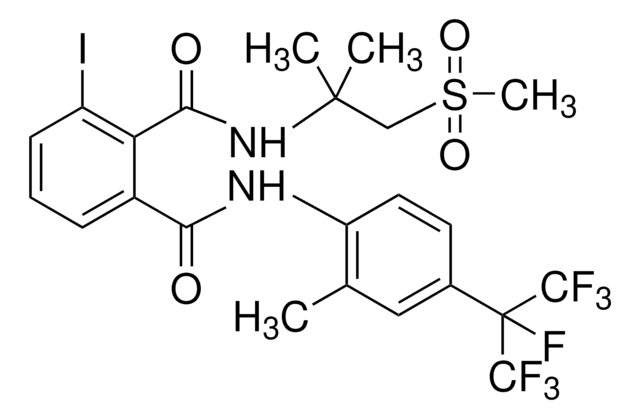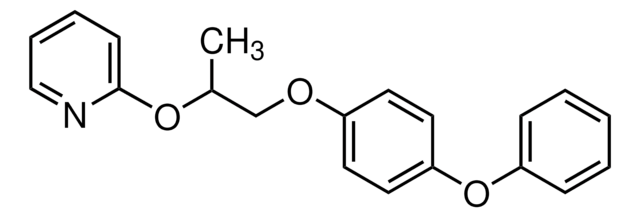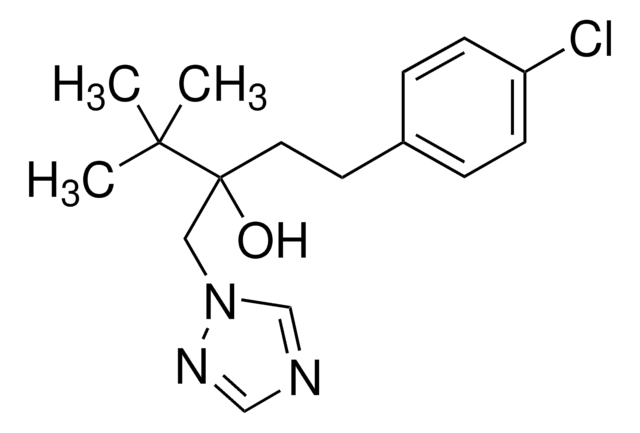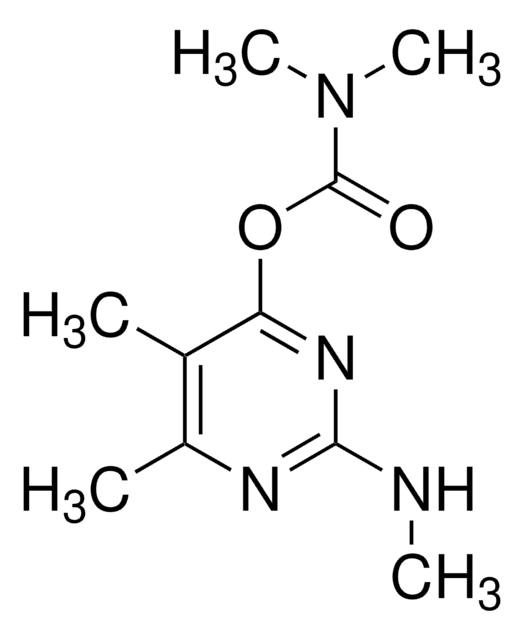32393
Pyridalyl
PESTANAL®, analytical standard
Synonym(e):
2-{3-{2,6-Dichlor-4-[(3,3-dichlor-2-propen-1-yl)-oxy]-phenoxy}-propoxy}-5-(trifluormethyl)-pyridin, [2,6-Dichlor-4-(3,3-dichlorallyloxy)-phenyl]-3-(5-trifluormethyl-2-pyridyloxy)-propylether
About This Item
Empfohlene Produkte
Qualität
analytical standard
Qualitätsniveau
Produktlinie
PESTANAL®
Haltbarkeit
limited shelf life, expiry date on the label
Anwendung(en)
agriculture
environmental
Format
neat
SMILES String
ClC1=C(OCCCOC2=NC=C(C(F)(F)F)C=C2)C(Cl)=CC(OCC=C(Cl)Cl)=C1
InChI
1S/C18H14Cl4F3NO3/c19-13-8-12(27-7-4-15(21)22)9-14(20)17(13)29-6-1-5-28-16-3-2-11(10-26-16)18(23,24)25/h2-4,8-10H,1,5-7H2
InChIKey
AEHJMNVBLRLZKK-UHFFFAOYSA-N
Suchen Sie nach ähnlichen Produkten? Aufrufen Leitfaden zum Produktvergleich
Allgemeine Beschreibung
Pyridalyl has to be monitored in the Multiannual Control Programme for Pesticides Residues (MACP), run within the EU and EFTA in/on products of plant origin.
Pyridalyl was approved on 1 July 2014 under the Commission Regulation (EU) No 143/2014/EU as per the Regulation (EC) No 1107/2009 as amended by Commission Implementing Regulations (EU) No 540/2011 and 541/2011. Upon receiving an application to set the new MRLs for pyridalyl from the Evaluating Member State (EMS) following Article 9 of the Regulation on 14 January 2009, EFSA has proposed an MRL of 1 mg/kg for tomatoes, 1 mg/kg for aubergines (eggplants), 2 mg/kg for peppers, 0.2 mg/kg for cucurbits (inedible peel), 3 mg/kg for lettuce, and 0.1 mg/kg for cottonseed.
Anwendung
- To determine the toxicity of pyridalyl on each growth stage of 2 insect pest species and to evaluate its cytotoxicity on the Sf9 insect and CHO-K1 mammalian cell line using the trypan blue exclusion method
- To assess the lethal and sublethal effects of methoxyfenozide and pyridalyl on the larval ectoparasitoid Habrobracon hebetor
- Investigation of the molecular action of Pyridalyl via cytochrome P450 activity using non-selective cytochrome P450 inhibitor, 1-ABT (1-aminobenzotriazole)
- Evaluation of in vitro insecticidal activity of pyridalyl nanosuspension in comparison to technical material and commercial product against tomato fruit and shoot borer (Helicoverpa armigera)
- To elucidate the persistence behavior and risk assessment of pyridalyl in tomato, cabbage, and cultivated field soil over two consecutive seasons
Empfohlene Produkte
Rechtliche Hinweise
Signalwort
Warning
H-Sätze
Gefahreneinstufungen
Aquatic Acute 1 - Aquatic Chronic 1 - Skin Sens. 1
Lagerklassenschlüssel
10 - Combustible liquids
WGK
WGK 3
Flammpunkt (°F)
Not applicable
Flammpunkt (°C)
Not applicable
Hier finden Sie alle aktuellen Versionen:
Besitzen Sie dieses Produkt bereits?
In der Dokumentenbibliothek finden Sie die Dokumentation zu den Produkten, die Sie kürzlich erworben haben.
Unser Team von Wissenschaftlern verfügt über Erfahrung in allen Forschungsbereichen einschließlich Life Science, Materialwissenschaften, chemischer Synthese, Chromatographie, Analytik und vielen mehr..
Setzen Sie sich mit dem technischen Dienst in Verbindung.










